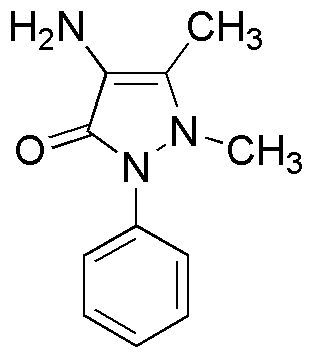4-Aminoantipyrine is widely utilized in research focused on:
- Analytical Chemistry: It serves as a reagent in colorimetric assays for determining the concentration of various substances, particularly in clinical laboratories for blood glucose testing.
- Pharmaceutical Development: This compound is used in the synthesis of various pharmaceuticals, especially in developing anti-inflammatory and analgesic medications, providing a foundation for new drug formulations.
- Biochemical Research: It plays a role in studying enzyme activities and mechanisms, particularly in the context of oxidative stress and metabolic pathways, aiding researchers in understanding disease processes.
- Food Industry: Employed in the detection of certain food contaminants, 4-Aminoantipyrine helps ensure food safety by identifying harmful substances in food products.
- Environmental Monitoring: It is utilized in the analysis of water quality, helping to detect pollutants and assess the impact of industrial discharges on aquatic ecosystems.
General Information
Properties
Safety and Regulations
Applications
4-Aminoantipyrine is widely utilized in research focused on:
- Analytical Chemistry: It serves as a reagent in colorimetric assays for determining the concentration of various substances, particularly in clinical laboratories for blood glucose testing.
- Pharmaceutical Development: This compound is used in the synthesis of various pharmaceuticals, especially in developing anti-inflammatory and analgesic medications, providing a foundation for new drug formulations.
- Biochemical Research: It plays a role in studying enzyme activities and mechanisms, particularly in the context of oxidative stress and metabolic pathways, aiding researchers in understanding disease processes.
- Food Industry: Employed in the detection of certain food contaminants, 4-Aminoantipyrine helps ensure food safety by identifying harmful substances in food products.
- Environmental Monitoring: It is utilized in the analysis of water quality, helping to detect pollutants and assess the impact of industrial discharges on aquatic ecosystems.
Documents
Safety Data Sheets (SDS)
The SDS provides comprehensive safety information on handling, storage, and disposal of the product.
Product Specification (PS)
The PS provides a comprehensive breakdown of the product’s properties, including chemical composition, physical state, purity, and storage requirements. It also details acceptable quality ranges and the product's intended applications.
Certificates of Analysis (COA)
Search for Certificates of Analysis (COA) by entering the products Lot Number. Lot and Batch Numbers can be found on a product’s label following the words ‘Lot’ or ‘Batch’.
*Catalog Number
*Lot Number
Certificates Of Origin (COO)
This COO confirms the country where the product was manufactured, and also details the materials and components used in it and whether it is derived from natural, synthetic, or other specific sources. This certificate may be required for customs, trade, and regulatory compliance.
*Catalog Number
*Lot Number
Safety Data Sheets (SDS)
The SDS provides comprehensive safety information on handling, storage, and disposal of the product.
DownloadProduct Specification (PS)
The PS provides a comprehensive breakdown of the product’s properties, including chemical composition, physical state, purity, and storage requirements. It also details acceptable quality ranges and the product's intended applications.
DownloadCertificates of Analysis (COA)
Search for Certificates of Analysis (COA) by entering the products Lot Number. Lot and Batch Numbers can be found on a product’s label following the words ‘Lot’ or ‘Batch’.
*Catalog Number
*Lot Number
Certificates Of Origin (COO)
This COO confirms the country where the product was manufactured, and also details the materials and components used in it and whether it is derived from natural, synthetic, or other specific sources. This certificate may be required for customs, trade, and regulatory compliance.


